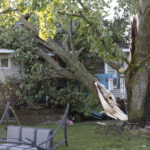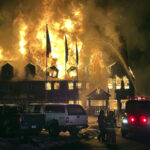Catastrophe models have become such an indispensable tool for re/insurers, particularly those who write P&C catastrophe coverage, that it’s hard to believe the service is only 25 years old. It was launched in 1987 under the direction of Karen Clark, who headed Applied Insurance Research (now AIR Worldwide). The goal of predicting the consequences from any given nat cat hasn’t changed, but the means employed to assess those probabilities has reached new levels of sophistication.
“The models we create are designed to give some idea of future losses,” said AIR’s current president and CEO, S. Ming Lee, in an interview at the Reinsurance Rendezvous in Monte Carlo. He has been with the company since 1996 and became president in 2007, follwing its acquisition by Verisk Insurance Solutions.
He explained that in analyzing the hazards AIR determines where they are likely to occur, how frequently and how big they could be. That’s essentially what cat modelers have always done. The changes that have been made over the years are in the ways that they do it.
The process still begins with historical data – ground motion (for earthquakes), wind speeds (for hurricanes and other storms), flood data from past events, etc. But “historical experience is not enough to view what could happen,” said Ming Lee. “You have to determine a range of possibilities.”
“For hurricanes the central pressure determines the wind speed,” he explained. “But the damages it may cause depend on other factors.” These include differences in elevation, coastal contours, tides, which affect storm surge, and the types of structures in any given area, building codes and the level of their enforcement. Putting all that together is termed “wind engineering.”
AIR’s analysis of other types of hazards follows a similar path. “In assessing today’s risks we also look at the long term in order to understand what the possibilities are, and how they may change,” said Jayanta (Jay) Guin, Sr. VP for Research and Modeling at AIR. “We develop models on weather patterns for two decades, based on our understanding of present conditions and the relative likelihood of what can happen in the future.”
Constructing those models requires reducing the increasingly large number of data sets into mathematical formulas, the “model input.” Advances in computer technology have made it possible to achieve far greater accuracy. However, “they are very complex; they aren’t perfect,” said Guin: “there’s always going to be some uncertainty, as we are dealing with probabilities.”
How complex and how accurate are some of the new models from AIR, EQECAT and RMS? Guin gave an example from AIR’s flood model, which is in preparation. “It covers all 48 contiguous U.S. states, and provides probability simulations for 10,000 years; it consists of 50 terabytes (1 of which equals 1000 gigabytes).” Ming Lee noted that in some areas it can assess probabilities on a house by house basis.
The effort that’s gone into creating that model is immense. Ming Lee explained that for a model on that scale it takes around “12 person years,” i.e. it would take one person 12 years. For the U.S. flood model AIR assigned a team of 16 people, who were responsible for gathering the data, “the science.” A similar-sized software team is now at work inputting that data, and creating the actual model.
Even given that level of sophistication, uncertainty still exists. “Nature acts in random ways,” said Ming Lee, adding that one should “never forget that we are dealing with probabilities. An earthquake in a given area, where the homes are essentially the same, will cause a widely different range of damages” – from complete destruction to none. “Commercial buildings are all different for damages,” he added.
Re/insurance companies “use models to diversify their risks,” Ming Lee said. They assess those risks from both a geographical standpoint and the level of potential nat cat activity. They [the models] give re/insurers “a sense of their exposure(s)” and thus help determine “their appetite for risk,” compared with other perils in a given region. “Models help quantify risks; they help set the price – to set what premiums should be.” That balance may, or may not, result in other companies deciding to enter a given market.
Ming Lee also observed that the level of sophistication reached by the firms that provide the insurance industry with its cat models has developed “into a language – a currency to understand risks and to transfer risks. It provides a benchmark,” which enables companies to more accurately adjust their business.
Cat models have historically been used almost exclusively in assessing P&C risks. Given the advances that have been made in their preparation, they may be of significant use in other fields. “There are models for terrorism, industrial accidents and global pandemic flu,” said Guin. “There are also crop insurance models, used mainly be reinsurers in both the U.S. and China.”
How cat models are used has changed as well. Karen Clark’s famous observation that people were using the models on a “garbage in, gospel out” basis may no longer be the case. Cat modelers have long cautioned their clients, as noted above, that they are providing probabilities, not predicting the future, which all of them acknowledge would be impossible. In addition more re/insurers, brokers and the clients they serve are looking to their own models in conjunction with those supplied by AIR, RMS and EQECAT, to assess their specific risks.
Topics Catastrophe USA Reinsurance
Was this article valuable?
Here are more articles you may enjoy.


 Trump to Issue Order Creating National AI Rule
Trump to Issue Order Creating National AI Rule  One of Highest Property Claims Severity Recorded in Q3 on Low Volume, Says Verisk
One of Highest Property Claims Severity Recorded in Q3 on Low Volume, Says Verisk  Owner of Historic Minnesota Resort Charged With Arson, Insurance Fraud
Owner of Historic Minnesota Resort Charged With Arson, Insurance Fraud  Brookfield Targets Global Dominance in P/C Insurance Coverage
Brookfield Targets Global Dominance in P/C Insurance Coverage 

